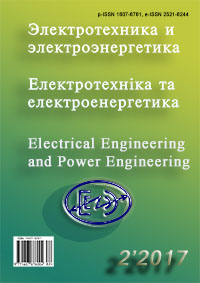TOPOLOGICAL TRANSIENT MODELS OF THREE-PHASE FIVE-LIMB TRANSFORMER
DOI:
https://doi.org/10.15588/1607-6761-2017-2-2Keywords:
five-limb transformer, topological transient models, transients, off-core magnetic fluxes, current waveforms, reactive power, experimental validation, back-to-back transformer testAbstract
Purpose. To show capabilities of topological models of three-phase, five-limb transformer to correctly represent transformer operation in regimes with high flux densities in the core. As a practically important example, time domain response of transformer subjected to geomagnetically induced currents (GIC) is analyzed and compared with results of a comprehensive field experiment.Methodology. Transformer magnetic model, which takes into account geometry of the core and windings, is transformed in a dual electric equivalent scheme, whose transient is calculated by using EMTP-ATP. The results obtained demonstrate the importance of incorporating the positive and zero sequence impedances of power network.Findings. A simple and reliable model of five-limb transformer is proposed. It was found that the presence of the transformer tank can be effectively accounted for by linear inductances representing the paths of the off-core fluxes from yoke to yoke. The modeling of GIC events represented in the paper is the most accurate ever obtained for three-phase, five-leg transformers. The model is validated by close agreement of the predicted values and waveforms of the phase currents and reactive power with those measured in tests performed on two 400 MVA transformers connected back-to-back and to a 400 kV power network.Originality. It is shown that a simplified non-hysteresis model developed portrays the behavior of the of five-limb transformer under GIC condition with the same good accuracy as its hysteresis model. Both the transformer models are well grounded. So, the paper dispels some misconceptions about the influence of the hysteresis properties of the core material and tank in transient modeling of five-leg transformers.Practical value. The practical value and significance of the paper is caused by the fact that the model proposed is a simple and reliable tool for power system studies. The paper warns of using unnecessary complicated models whose parameters are difficult to be estimated by experiments or calculations.
References
Arturi, C. M. (1991). Transient simulation of a three phase five limb step-up transformer following an out-of-phase synchronization. IEEE Trans. Power Delivery, 6, 1, 196 – 207. DOI: 10.1109/61.103738.
Chen, X., Venkata, S.S. (1997). A three-phase three-winding core-type transformer model for low-frequency transient studies. IEEE Trans. Power Delivery, 12, 2, 775 – 782. DOI: 0885-8977/97/$10.00.
Mork, B. A., Gonzalez, F., Ishchenko, D., Stuehm, D. L., Mitra J. (2007). Hybrid transformer model for transient simulation – Part I: Development and parameters. IEEE Trans. Power Delivery, 22, 1, 248 – 255. DOI: 10.1109/TPWRD.2006.883000.
Zirka, S. E., Moroz, Y. I., Arturi, C. M. (2014). Accounting for the influence of the tank walls in the zero-sequence topological model of a three-phase, three-limb transformer. IEEE Trans. Power Delivery, 29, 5, 2172–2179. DOI: 10.1109/ TPWRD.2014.2307117.
Zirka, S. E., Moroz, Y.I., Høidalen, H. Kr., Lotfi, A., Chiesa, N., Arturi, C. M. (2017). Practical experience in using a topological model of a core-type three-phase transformer – No-load and inrush conditions. IEEE Trans. Power Delivery, 32, 4, 2081–2090. DOI: 10.1109/TPWRD. 2016.2618900.
Tikhovod, S.M. (2014). Modelirovanie perehodnyh processov v transformatorah na osnove magnitojelektricheskih shem zameshhenija. [Modeling transformer transients using magnitoelectric equivalent schemes]. Elektrotehnika i elektroenergetika, 2, 59-68, (in Russian).
Lahtinen, M., Elovaara, J. (2002). GIC occurrences and GIC test for 400 kV system transformer. IEEE Trans. Power Delivery, 17, 2, 555–561. DOI: 0885-8977(02)02750-4.
Rezaei-Zare, A. Marti, L., Narang, A., Yan, A. (2016). Analysis of three-phase transformer response due to GIC using an advanced duality-based model. IEEE Trans. Power Delivery, 31, 5, 2342–2350. DOI: 10.1109/TPWRD. 2015.2505499.
Rezaei-Zare, A. (2015). Enhanced transformer model for low- and mid-frequency transients–Part I: Model development. IEEE Trans. Power Delivery, 30, 1, 307–315. DOI: 10.1109/TPWRD.2014.2347930.
Rezaei-Zare, A. (2015). Enhanced transformer model for low- and mid-frequency transients–Part II: Validation and simulation results. IEEE Trans. Power Delivery, 30, 1, 316–325. DOI: 10.1109/TPWRD.2014.2347934.
Lambert, M., Mahseredjian, J. (2013) Electromagnetic transient type transformer models for geomagnetically-induced current (GIC) studies. EPRI Report 3002000832.
Zirka, S. E., Moroz, Y. I., Rahimpour, E. (2017). Towards a transformer transient model as a lumped-distributed parameter system. Compel, 36, 3, 741–750. DOI: 10.1108/COMPEL-09-2016-0389.
Zirka, S. E., Moroz, Y. I., Chiesa, N., Harrison, R. G., Høidalen, H. Kr. (2015). Implementation of inverse hysteresis model into EMTP – Part II: Dynamic model. IEEE Trans. Power Delivery, 30, 5, 2233–2241. DOI: 10.1109/TPWRD. 2015.2416199.
Moroz, Y. I., Zirka, S. E. (2014). Inverse models of magnetic hysteresis, [Online]. Available: https://sites.google.com/site/inverse-hysteresismodel.
Alternative Transients Program, ATP-EMTP, (2016). [Online]. Available: http://www.eeug.org.
Tleis, N. D. (2008). Power systems modelling and fault analysis: Theory and practice. New York: Newnes/Elsevier, 625.
Evdokunin, G. A. (2016). Jelektricheskie sistemy i seti [Electrical systems and networks]. Saint Petersburg: Rodnaya Ladoga, 384, (in Russian).
Downloads
Published
How to Cite
Issue
Section
License
Copyright (c) 2018 S. E. Zirka, Y. I. Moroz, C. M. Arturi, D. Bonnman

This work is licensed under a Creative Commons Attribution 4.0 International License.
Creative Commons Licensing Notifications in the Copyright Notices
Authors who publish with this journal agree to the following terms:
Authors retain copyright and grant the journal right of first publication with the work simultaneously licensed under aCreative Commons Attribution License that allows others to share the work with an acknowledgement of the work's authorship and initial publication in this journal.
Authors are able to enter into separate, additional contractual arrangements for the non-exclusive distribution of the journal's published version of the work (e.g., post it to an institutional repository or publish it in a book), with an acknowledgement of its initial publication in this journal.
Authors are permitted and encouraged to post their work online (e.g., in institutional repositories or on their website) prior to and during the submission process, as it can lead to productive exchanges, as well as earlier and greater citation of published work.

